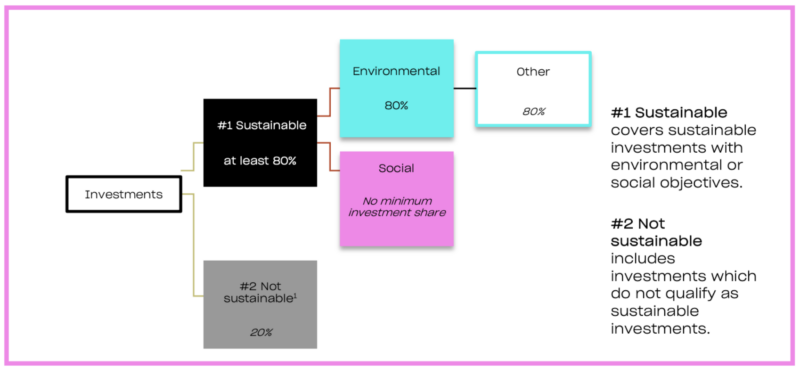
SFDR
DISCLOSURES PURSUANT TO THE SUSTAINABLE FINANCE DISCLOSURE REGULATION (EU) 2019/2088
AENU Fund SCA SICAV-RAIF is a partnership limited by shares (société en commandite par actions) qualifying as a reserved alternative investment fund – investment company with variable share capital (Société d’Investissement à Capital Variable – Fonds d’Investissement Alternatif Réservé) under the laws of the Grand Duchy of Luxembourg, registered with the Luxembourg trade and companies register (Registre de Commerce et des Sociétés) of Luxembourg under number B 261584, having its registered address at 1c, Rue Gabriel Lippmann, L-5365 Munsbach, Grand Duchy of Luxembourg, acting through and represented by its general partner (gérant) AENU GP S.à r.l., a private limited liability company (société à responsabilité limitée) under the laws of the Grand Duchy of Luxembourg, registered with the Luxembourg trade and companies register (Registre de Commerce et des Sociétés) of Luxembourg under number B 258815, having its registered address at 1c, Rue Gabriel Lippmann, L-5365 Munsbach, Grand Duchy of Luxembourg
Summary
AENU Fund SCA SICAV-RAIF (the “Fund”) invests in early venture stage companies addressing global environmental challenges. The Fund has sustainable investments as its objective. It will make a minimum share of 80% of sustainable investments with an environmental objective. In line with this a sustainable investment for the Fund is defined as an investment in an economic activity that contributes to an environmental objective, provided that the investment does not significantly harm any environmental or social objective and that the investee companies follow good governance practices. A portion of the Fund’s investments (up to 20 %) can be held as ancillary liquidity or tactically invested in Put-Options/Warrants to hedge the public market equity long-positions in case of an expected market- downturn.
The Fund has set up an integrated impact / ESG & business diligence process that takes into account positive and negative outcomes and externalities.
To qualify for investment of the Fund, a company must demonstrate that its commercial success is directly tied to creating a positive impact (referred to as “Impact Interlock” within the Fund’s Impact Guidelines). Each investment must show potential for measurable impact in alignment with at least one of the UN SDGs or environmental objectives, including climate change mitigation, climate change adaptation, sustainable use of water and marine resources, transition to a circular economy, pollution prevention, and the protection and restoration of biodiversity and ecosystems. Within these sustainable objectives the Fund invests sector- and tech-agnostic into transitional, enabling, or direct impact businesses.
Furthermore, a part of the Fund’s impact analysis during investment process and portfolio management for each Investee Company and its products/services is a “do no significant harm” (DNSH) analysis based on the principles of adverse impact indicators (“PAIs”).
Post investment the Fund has an engagement strategy (“impact-as-a- service), which includes, among other, impact & ESG KPI and target setting for every investment.
To monitor and report its performance regarding the sustainable investment objectives and principles of adverse impact, the Fund collects data annually from its investee companies. This data includes information on adverse impacts and relevant impact indicators, enabling the Fund to provide comprehensive yearly portfolio reports to its investors.
To assess good governance practices of the Investee Companies, the Fund evaluates the ESG points during the investment process through direct conversations with founders and through its ESG questionnaire.
The Investment Advisor’s research has shown there are currently no specifically and significantly relevant benchmarks available for products categorized under Article 9 SFDR investing in early-stage venture and technology-companies that invest across both private and public markets. Therefore, there is no benchmark chosen for the Fund.
No significant harm to the sustainable investment objective
The Fund’s sustainability and impact assessments have two objectives: (1) to assess and validate the net positive outcomes of a potential investment against its impact guidelines and impact investment thresholds and (2) ensure adherence to the do no significant harm principles and that any potential negative outcomes or controversies associated with the OECD Guidelines for multinational companies and/or the UN Global Compact are understood, managed and mitigated.
In order to analyze potential negative outcomes, the Fund first conducts an internal theory of change assessment that takes into account impact logic steps, which help guide due diligence efforts. From an impact perspective, the Fund evaluates impact risks and corresponding mitigation strategies. These risks might result from the product, the business model, or the operations of the company, among others. To the extent that a life cycle assessment (LCA) is key in understanding the positive and negative outcomes of a product or service, the Fund either analyzes peer reviewed scientific studies or company LCAs.
The Fund also assesses environmental, social and governance risks and opportunities during the investment process through management conversations and a sustainability questionnaire and integrates this information into the final investment decision and post-investment engagement strategy. These ESG factors include the principal of adverse impact indicators that are relevant to the specific company being evaluated.
Should a potential investment or portfolio company fail to meet the ‘do no significant harm’ safeguards, the Fund might decide to issue a negative investment decision or follow-on recommendation.
Sustainable investment objective of the financial product
The Fund operates under sustainable investment objectives that are linked to corresponding sustainability indicators. These indicators are integrated into the entire value- and process-chain for its investment decision-making and post-investment engagement strategy:
The (qualitative) sustainable investment objective of the Fund is to provide value-additive capital for tech-entrepreneurs who help solving the climate crisis and advance (climate) justice. It invests in inclusive and ambitious founders who are building impact technologies that have the potential to reduce significant CO2e at scale.
The majority of investments are geared towards climate impact in terms of reduction or removal of CO2e emissions. However, the Fund is able to also invest in social investments that aim to advance social equality and empower people in relation to the United Nations sustainable development goals with special focus on quality education. Even though, social investments are not a primary objective of the Fund.
As part of this (on a quantitative level), every investment must have the potential to demonstrate measurable impact in accordance with either one of the United Nations Sustainable Development Goals (the “UN SDGs”) or at least one of the environmental objectives, namely:
- (a) climate change mitigation;
- (b) climate change adaptation;
- (c) sustainable use and protection of water and marine resources;
- (d) transition to a circular economy;
- (e) pollution prevention and control;
- (f) the protection and restoration of biodiversity and ecosystems.
Consequently, the Fund invests on a sector-agnostic and tech-agnostic level with the aim of financing both transitional, enabling, and direct impact companies that align with the previously outlined objectives.
Investment strategy
First, the Fund’s investment strategy is focused on companies whose products or services inherently contribute towards sustainable investment objectives. As a first step, every potential investment has to be assessed against the Fund’s impact guidelines: Intentionality, Impact Logic Model, Interlock, Impact Scale, Additionality and Impact Measurement.
Second, the Fund’s investment focus is categorized in five high-level clusters, while each of the clusters is subdivided into several sub-clusters that are each guided by a specific investment thesis: Energy Transition, Carbon Economy, Ecosystems & Biodiversity, Industrial Decarbonization and Climate Jobs/Education.
In each cluster, different technologies are applied to achieve the sustainable investment objective. Typically, the product strategies of the investee companies aim to improve, mitigate, or adapt to environmental/climate challenges, to implement circularity in certain industries or for certain resources, to preserve, protect or restore certain resources or ecosystems (including e.g. biodiversity), or to improve lives and livelihoods.
Third, specific impact and ESG assessments regarding the sustainable investment objective and good governance practices are integrated across the entire investment process, governance, and portfolio management of the Fund. As part of its prohibited investments policy the Fund has explicitly excluded investments in harmful industries such as fossil fuels, tobacco, firearms, nuclear weapons, pornography, and alcohol, among others.
Proportion of investments
The fund invests in early stages, primarily in Europe.
At least 80% of the Fund’s investments will qualify as sustainable investments. A minimum of 80% are direct investments into climate startups (pursuing environmentally sustainable objectives). The Fund has no minimum commitments in relation to social investments or investments aligned with the EU Taxonomy.
The 20% designated for “non-sustainable” investments comprises two components: investments intended for liquidity purposes and to hedge the Fund, and Micro Investments that, are exempt from scrutiny and reporting due to their lack of economic significance for the Fund but generally still adhere to its sustainable investment objectives.
Monitoring of the sustainable investment objective
As part of the Funds aligned commitment to ensure a substantial contribution to sustainability, it aims to sign an impact & ESG clause with portfolio companies. This clause includes a series of commitments, from carbon accounting to impact management. Whenever possible, the Fund selects impact and ESG performance indicators and annual targets with each portfolio company. Data is collected, at least, on an annual basis, and then used in sustainability engagement conversations with the responsible impact & ESG officer. Based on the assessment, the Fund provides and tailors impact & ESG resources.
As part of its periodic disclosure the Fund will exclusively report the aggregated (primary) Fund Key Performance Indicators (KPIs) and will provide detailed reports on the underlying KPIs for individual portfolio companies.
Note: ESG & impact measurement / management and the Impact Clause can only be guaranteed to be implemented at those portfolio companies where the Fund is leading/co-leading the investment round or has sufficient influence over the company’s other investors and management.
